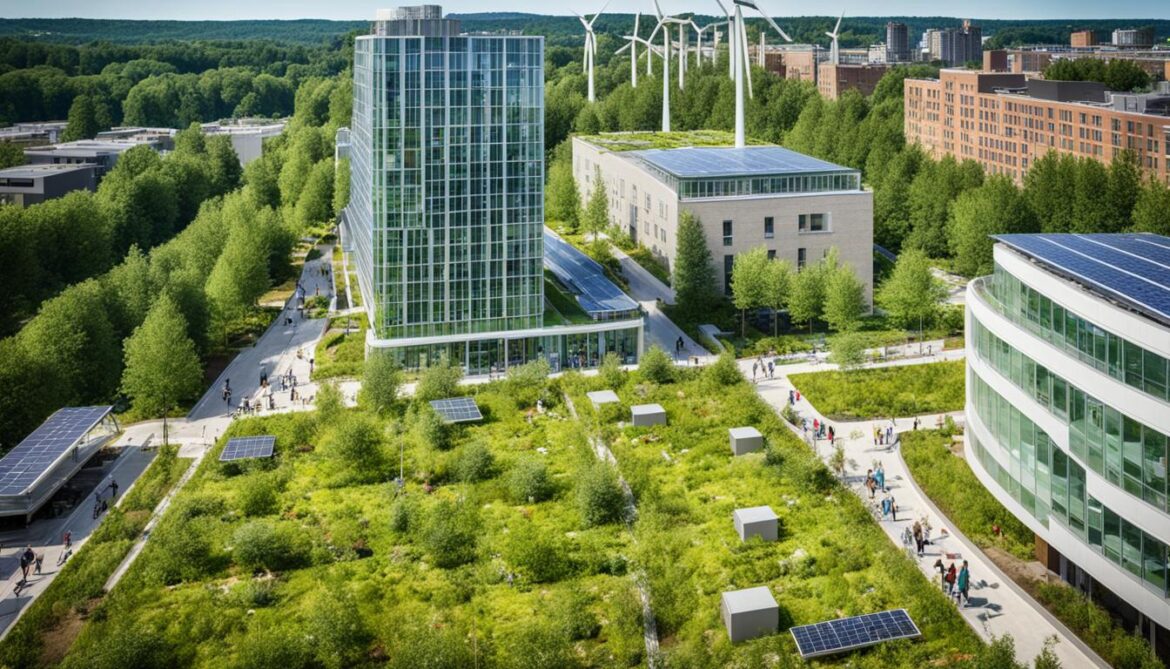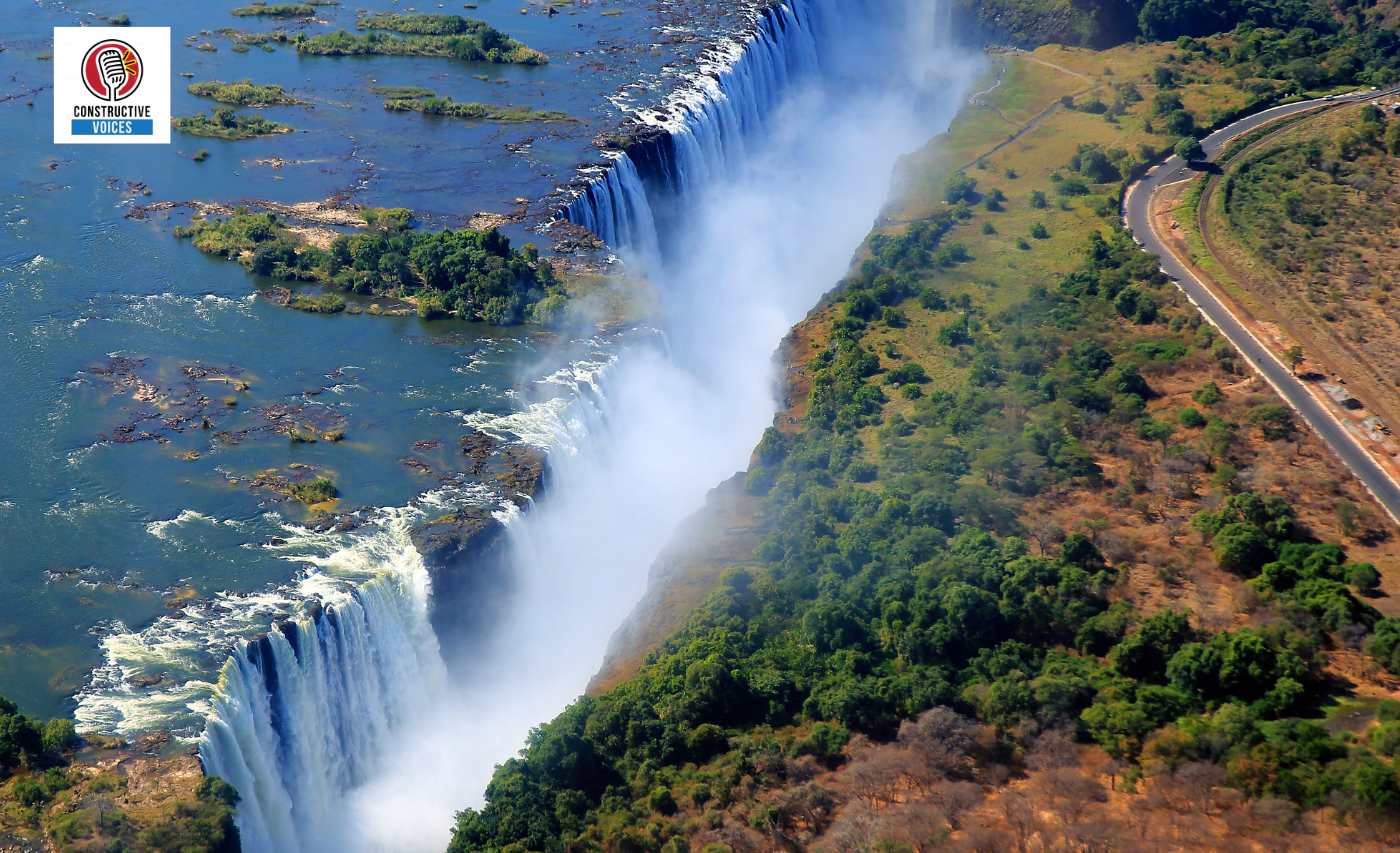Zimbabwe Biodiversity and the Built Environment
Zimbabwe is renowned for its rich biodiversity, boasting over 5,000 species of plants and 6,000 species of animals. However, this precious ecosystem is facing numerous threats that require urgent conservation efforts. From habitat destruction to climate change, it is crucial to protect Zimbabwe’s wildlife and ecosystems for a sustainable future.
The country has taken significant steps towards conservation through policies and initiatives that promote the protection of biodiversity. In Harare, sustainable architecture practices are being embraced to ensure eco-friendly urban planning. Meanwhile, in Bulawayo, there is a growing focus on eco-friendly urban planning to preserve urban biodiversity. These green building initiatives in Harare and urban biodiversity conservation efforts in Zimbabwe are testament to the country’s commitment to sustainable development.
Key Takeaways:
- Zimbabwe’s biodiversity is under threat and requires conservation efforts.
- Sustainable architecture practices in Harare and eco-friendly urban planning in Bulawayo contribute to biodiversity conservation.
- Protecting wildlife in Zimbabwe is crucial for a sustainable future.
- Green building initiatives in Harare and urban biodiversity conservation efforts in Zimbabwe are essential.
- Zimbabwe’s commitment to sustainable development is evident through its conservation policies and initiatives.
Key Policies and Governance Approach in Biodiversity Conservation
Zimbabwe has taken significant steps to protect and conserve its biodiversity. The country’s commitment to global biodiversity conservation efforts is demonstrated through its signing and ratification of the Convention on Biological Diversity (CBD).
To effectively safeguard biodiversity, Zimbabwe has developed National Biodiversity Strategy and Action Plans (NBSAPs). These NBSAPs serve as a roadmap for mainstreaming biodiversity conservation across government sectors and society.
The Ministry of Environment, Water, and Climate, in collaboration with the Zimbabwe Parks and Wildlife Management Authority (ZPWMA) and other stakeholders, is responsible for implementing these NBSAPs.
Strategies for Biodiversity Conservation
The National Biodiversity Strategy and Action Plans (NBSAPs) outline various strategies aimed at protecting Zimbabwe’s biodiversity:
- Reducing direct pressures on biodiversity
- Improving the status of ecosystems and species
- Enhancing benefits derived from biodiversity
- Strengthening implementation through participatory planning and capacity building
By reducing direct pressures on biodiversity, Zimbabwe aims to mitigate threats such as habitat destruction and invasive species. Improving the status of ecosystems and species involves targeted conservation efforts to restore and preserve the unique flora and fauna of the country. Enhancing benefits from biodiversity includes supporting sustainable livelihoods and promoting sustainable use of natural resources.
Through participatory planning and capacity building, Zimbabwe aims to strengthen the implementation of biodiversity conservation measures, ensuring effective management and long-term preservation of its rich natural heritage.
“The National Biodiversity Strategy and Action Plans (NBSAPs) provide a comprehensive framework for protecting Zimbabwe’s biodiversity and guide our efforts in achieving sustainable development.” – Ministry of Environment, Water, and Climate
By aligning policies, engaging stakeholders, and implementing these strategies, Zimbabwe aims to create a sustainable future that values and preserves its biodiversity.
Implementation of NBSAPs
The Ministry of Environment, Water, and Climate actively collaborates with the Zimbabwe Parks and Wildlife Management Authority (ZPWMA) to ensure the effective implementation of the National Biodiversity Strategy and Action Plans (NBSAPs).
This collaborative approach involves:
- Engaging government sectors to mainstream biodiversity conservation
- Facilitating capacity building initiatives
- Encouraging participation from local communities
- Strengthening enforcement and monitoring mechanisms
By working together, Zimbabwe can achieve its conservation goals and secure the long-term sustainability of its unique wildlife and ecosystems.
| Key Stakeholders | Implementation Progress |
|---|---|
| Ministry of Environment, Water, and Climate | Actively championing biodiversity conservation efforts |
| Zimbabwe Parks and Wildlife Management Authority (ZPWMA) | Collaborating with the Ministry to ensure effective implementation |
| Government Sectors | Mainstreaming biodiversity conservation into policies and practices |
| Local Communities | Engaging in participatory planning and capacity building initiatives |
The implementation of NBSAPs plays a vital role in safeguarding Zimbabwe’s biodiversity by addressing the direct pressures, enhancing ecosystem resilience and promoting sustainable use of natural resources.
Zimbabwe’s commitment to biodiversity conservation sets a positive example for other nations and strengthens global efforts to protect our planet’s rich natural heritage.
Protected Areas in Zimbabwe
Zimbabwe boasts a remarkable collection of 232 protected areas, covering approximately 27.2% of the country’s landmass. These protected areas include national parks, wildlife estates, gazetted forests, conservancies, and CAMPFIRE areas.
The Zimbabwe Parks and Wildlife Management Authority (ZPWMA) manages and operates 11 national parks, including renowned destinations like Hwange, Mana Pools, and Matobo. These national parks play a crucial role in the conservation of Zimbabwe’s biodiversity and offer exceptional opportunities for wildlife viewing and ecotourism.
“Visiting these protected areas allows visitors to experience Zimbabwe’s diverse flora and fauna in their natural habitats while supporting the conservation initiatives that ensure their long-term preservation.”
Breathtaking National Parks and their Contributions to Biodiversity Conservation
Among Zimbabwe’s national parks, Hwange National Park is the largest, spanning over 14,600 square kilometers. It is home to a vast array of wildlife, including the majestic African elephant, lion, and buffalo.

Mana Pools National Park, a UNESCO World Heritage site, is known for its breathtaking landscapes and diverse ecosystem. Visitors can witness the incredible sight of elephants standing on their hind legs to reach the nutritious fruit from the Mana Pools’ canopy trees.
Matobo National Park, also a UNESCO World Heritage site, is renowned for its dramatic rock formations and ancient San rock art. Wildlife such as rhinos, leopards, and sable antelopes roam freely in this stunning park.
- Hwange National Park
- Mana Pools National Park
- Matobo National Park
These national parks not only provide a safe haven for Zimbabwe’s rich biodiversity but also offer incredible opportunities for ecotourism. Visitors can embark on guided safaris, game drives, and bush walks, immersing themselves in the beauty of Zimbabwe’s natural landscapes.
The Importance of Protected Areas in Zimbabwe
Protected areas are vital for the conservation of Zimbabwe’s biodiversity. They serve as habitats for a wide range of plant and animal species and are crucial for ecological balance and the preservation of delicate ecosystems.
By supporting the Zimbabwe Parks and Wildlife Management Authority and visiting these protected areas, tourists contribute directly to the conservation efforts that safeguard the nation’s natural heritage. Their conservation and ecotourism activities generate revenue that is reinvested in the management and protection of Zimbabwe’s protected areas and the surrounding communities.
Conserving Zimbabwe’s Biodiversity through Ecotourism
“Visiting these protected areas allows visitors to experience Zimbabwe’s diverse flora and fauna in their natural habitats while supporting the conservation initiatives that ensure their long-term preservation.”
Ecotourism plays a crucial role in the conservation of Zimbabwe’s biodiversity. It combines sustainable tourism practices with environmental education, providing visitors with an opportunity to appreciate and understand the importance of preserving Zimbabwe’s natural ecosystems.
In addition to wildlife encounters, ecotourism activities include birdwatching, guided nature walks, and cultural interactions with local communities. These experiences not only enhance tourists’ appreciation for Zimbabwe’s natural and cultural heritage but also promote the sustainable development of local communities through community-based tourism initiatives.
In conclusion, Zimbabwe’s protected areas, including its national parks managed by the Zimbabwe Parks and Wildlife Management Authority, are essential for the conservation of the nation’s incredible biodiversity. These protected areas offer exceptional opportunities for ecotourism, allowing visitors to experience Zimbabwe’s diverse flora and fauna while contributing to the preservation of these natural treasures. By supporting sustainable tourism practices and conservation initiatives, tourists play a crucial role in ensuring the long-term survival and well-being of Zimbabwe’s unique ecosystems and wildlife.
Threats to Biodiversity in Zimbabwe
Biodiversity in Zimbabwe faces various threats that jeopardize ecosystems and species survival. These threats include habitat destruction, invasive alien species, climate change, and overexploitation of natural resources.
Habitat Destruction
Habitat destruction is a major threat to biodiversity in Zimbabwe. Activities such as urban housing construction, agriculture expansion, and mining result in the destruction and fragmentation of natural habitats. This disruption leads to the displacement, decline, or even extinction of species. It is essential to implement robust conservation measures and sustainable resource management practices to mitigate the impact of habitat destruction on Zimbabwe’s unique biodiversity.
Invasive Alien Species
Invasive alien species pose a significant threat to Zimbabwe’s biodiversity. These species outcompete native species for resources and disrupt the ecological balance of ecosystems. To protect the native flora and fauna, efforts must be made to control and eradicate invasive alien species through effective monitoring, research, and management strategies.
Climate Change
Climate change poses a direct threat to Zimbabwe’s biodiversity. Rising temperatures and changing rainfall patterns can have profound effects on reproductive cycles, migration patterns, and habitats of various species. To mitigate the impact of climate change on biodiversity, it is crucial to implement measures that reduce carbon emissions, promote sustainable land management practices, and enhance ecosystem resilience.
Overexploitation of Natural Resources
Unsustainable practices such as overhunting, illegal logging, and overfishing contribute to the decline of Zimbabwe’s biodiversity. These activities deplete natural resources and disrupt the delicate balance of ecosystems. To protect biodiversity, it is essential to promote sustainable resource management, enforce regulations, and educate communities about the importance of conservation.

| Threat | Description |
|---|---|
| Habitat Destruction | Driven by urban housing construction, agriculture expansion, and mining |
| Invasive Alien Species | Outcompete native species and disrupt the ecological balance |
| Climate Change | Rising temperatures and changing rainfall patterns impact reproductive cycles and increase vulnerability |
| Overexploitation of Natural Resources | Unsustainable practices like overhunting, illegal logging, and overfishing |
Addressing these threats requires a comprehensive approach that includes robust conservation measures, sustainable resource management practices, and effective monitoring and enforcement mechanisms. By safeguarding Zimbabwe’s unique biodiversity, we can ensure the long-term preservation of its natural heritage and contribute to a sustainable future for all.
Successes in Biodiversity Conservation in Zimbabwe
Zimbabwe has achieved significant successes in biodiversity conservation through the establishment of protected areas and the dedicated efforts of the Zimbabwe Parks and Wildlife Management Authority (ZPWMA). These protected areas, including national parks like Hwange, Mana Pools, and Matobo, serve as havens for endangered species and undisturbed natural habitats. They contribute to the preservation of Zimbabwe’s biodiversity and provide opportunities for wildlife viewing and ecotourism.
In Hwange National Park alone, an estimated 45,000 elephants roam freely, making it one of the largest elephant populations in the world. Mana Pools National Park, a UNESCO World Heritage Site, is renowned for its diverse wildlife, including lions, hippos, and crocodiles, while Matobo National Park is home to both black and white rhinos, among other species.
The ZPWMA has also implemented the National Fire Strategy, which has substantially reduced the number of veld fires, a significant threat to wildlife and ecosystems. By implementing controlled burning practices and raising awareness about fire prevention, the strategy has helped safeguard habitats and maintain ecological balance.
While these achievements are commendable, ongoing efforts to increase funding, enhance institutional capacity, and strengthen coordination among stakeholders are necessary to meet the national targets for biodiversity conservation in Zimbabwe.

Zimbabwe’s commitment to biodiversity conservation is evident in the preservation of its protected areas and the implementation of effective strategies such as the National Fire Strategy. By working together, government entities, conservation organizations, and local communities can ensure the long-term protection of Zimbabwe’s unique and diverse wildlife and ecosystems.
Zimbabwe’s Contribution to Climate Change Mitigation
Zimbabwe, although contributing less than 0.1% of global greenhouse gas emissions, has committed to reducing its emissions as part of the Paris Agreement. The country aims to reduce its emissions by 40% by 2030 across all sectors.
The energy sector accounts for about 34% of Zimbabwe’s total emissions, while agriculture and forestry contribute 58%, waste contributes 5%, and industrial processes contribute 3%.
To meet these emission reduction targets, Zimbabwe is implementing specific policies and measures. This includes expanding renewable energy generation to decrease dependency on fossil fuels, improving energy efficiency to minimize energy wastage, and adopting sustainable land management practices to reduce deforestation and promote carbon sequestration.
Through these efforts, Zimbabwe aims to mitigate climate change and achieve multiple co-benefits. By reducing greenhouse gas emissions, the country can improve public health by reducing air pollution and its associated health risks. Additionally, these actions will contribute to enhanced biodiversity conservation, protecting Zimbabwe’s unique ecosystems and wildlife. Furthermore, transitioning to renewable energy sources will increase access to reliable and affordable energy supplies, benefiting both urban and rural communities.

The Importance of Multi-Sectoral Cooperation
Addressing climate change requires a collaborative approach involving government agencies, private sectors, civil society, and citizens. Zimbabwe is committed to fostering multi-sectoral cooperation to implement effective climate change mitigation strategies.
Public-private partnerships, investment in sustainable technologies, capacity building, and knowledge sharing are vital for ensuring the successful achievement of emission reduction targets. By bringing together diverse stakeholders, Zimbabwe can combine resources, expertise, and innovation to drive sustainable development and create a low-carbon future.
Furthermore, international collaborations and sharing of best practices can accelerate progress towards climate change goals. By engaging with global initiatives, Zimbabwe can leverage international support and learn from successful experiences in emission reduction and climate change adaptation.
“Zimbabwe’s commitment to reducing greenhouse gas emissions demonstrates its dedication to preserving our planet for future generations. Through collaboration and concrete actions, we can address climate change and create a more sustainable and resilient Zimbabwe.”
By embracing climate change mitigation measures, Zimbabwe is not only contributing to global efforts to combat climate change but also positioning itself for a more sustainable and prosperous future. The reduction of greenhouse gas emissions, alongside the promotion of renewable energy, sustainable agriculture, and responsible waste management, will pave the way for a resilient and environmentally conscious Zimbabwe.
Local Benefits of Climate Change Actions in Zimbabwe
Implementing climate change actions in Zimbabwe not only helps meet international obligations but also brings numerous local benefits.
Reducing greenhouse gas emissions leads to lower air pollution, improving public health and reducing mortality rates caused by air pollution, road traffic accidents, and unsafe sanitation. The reduction in air pollution enhances the overall quality of life and creates a healthier environment for Zimbabweans.
“Reducing greenhouse gas emissions leads to lower air pollution, improving public health and reducing mortality rates caused by air pollution, road traffic accidents, and unsafe sanitation.”
Climate change actions in Zimbabwe also focus on sustainable land management and forest conservation. These measures contribute to improving biodiversity, protecting and enhancing Zimbabwe’s natural heritage, and supporting the tourism industry. By preserving and restoring ecosystems, Zimbabwe ensures the survival of diverse plant and animal species and enables visitors to experience the country’s rich natural beauty.
The access to reliable energy is another significant benefit that comes from climate change actions. By transitioning to clean energy sources, Zimbabwe can ensure economic growth, poverty alleviation, and improved living conditions. This shift away from traditional biomass fuels for cooking reduces indoor air pollution and provides a consistent energy supply for households and businesses.
“By transitioning to clean energy sources, Zimbabwe can ensure economic growth, poverty alleviation, and improved living conditions.”
These local benefits align with Zimbabwe’s National Development Strategy, which highlights the importance of sustainable development, poverty reduction, and environmental conservation. By focusing on climate change actions that improve public health, enhance biodiversity, and provide access to reliable energy, Zimbabwe is working towards a more sustainable and prosperous future for its people.

Sustainable Land Management in Zimbabwe
Zimbabwe has been implementing sustainable land management practices to mitigate the effects of climate change and promote environmental sustainability. These practices involve responsible land use planning, soil conservation, water management, and the promotion of agroforestry. By implementing sustainable land management techniques, Zimbabwe reduces soil erosion, improves water availability, and enhances soil fertility, leading to increased agricultural productivity and food security.
The Importance of Quantifying Local Benefits in Climate Change Plans
When it comes to climate change action, it is essential to view it as an opportunity to improve lives. One way to do this is by quantifying the local benefits that can be achieved alongside greenhouse gas emission reductions. By integrating this quantitative assessment of local benefits into climate change plans, countries can boost their national climate plans and contribute to meeting emission reduction timelines.
The case of Zimbabwe serves as a great example of how assessing the social, health, and development benefits of climate change actions can provide a positive incentive for countries to take action. By highlighting the immediate advantages of climate action, countries can build momentum and encourage greater participation from stakeholders.
Integrating the quantification of local benefits not only helps in establishing a holistic understanding of the benefits of climate change action but also leads to more comprehensive and effective national climate plans. By showcasing the positive impacts on local communities and ecosystems, countries can gain support and ensure the success of their climate change initiatives.
“Quantifying the local benefits of climate change action is key to building public and political support. It helps to demonstrate the multiple advantages of addressing climate change and encourages greater collaboration and engagement from all stakeholders.”
By quantifying these benefits, countries can emphasize the societal, economic, and environmental advantages that can be achieved through climate change action. This approach not only fosters greater public and political support but also allows for better resource allocation and planning to maximize the positive outcomes of climate initiatives.
Boosting National Climate Plans
Integrating the quantification of local benefits into climate change plans has the potential to boost national climate plans. By highlighting the immediate advantages that can be gained from taking action, countries can inspire greater collaboration and engagement.
This approach also helps in aligning climate change actions with national development goals, ensuring a more integrated and cohesive strategy. By quantifying the local benefits, decision-makers can make informed choices and prioritize actions that deliver the most significant positive impacts.
Emission Reduction Timelines
Quantifying local benefits alongside greenhouse gas emission reductions is especially crucial for meeting emission reduction timelines. By understanding the immediate advantages that can be gained from climate action, countries can drive greater urgency and commitment in achieving their emission reduction targets.
Additionally, by showcasing the positive impacts on local communities and ecosystems, countries can motivate stakeholders to take action and contribute to the overall emission reduction efforts. This multi-faceted approach ensures that climate change plans not only aim to reduce emissions but also deliver tangible and meaningful benefits to the local populations.
Conclusion
Protecting Zimbabwe’s biodiversity and combating climate change are essential for the country’s sustainable development. The integration of biodiversity into the built environment and the implementation of climate change actions have significant positive impacts on Zimbabwe’s natural heritage, public health, biodiversity conservation, and access to reliable energy. By investing in conservation efforts and taking steps to mitigate climate change, Zimbabwe can safeguard its unique biodiversity, strengthen ecosystem resilience, and enhance the well-being of its people.
Through a comprehensive approach that considers both global and local benefits, Zimbabwe has the potential to create a sustainable future for all. By recognizing the value of and preserving its natural resources, Zimbabwe can foster a harmonious coexistence between humans and the environment. This will not only protect the country’s rich biodiversity but also contribute to enhanced public health, increased access to reliable energy, and improved quality of life for its citizens.
Zimbabwe’s commitment to biodiversity conservation and climate change mitigation sets a positive example for other countries facing similar challenges. By prioritizing these efforts, Zimbabwe can make significant progress in achieving its sustainable development goals and becoming a leader in environmental stewardship. It is through the collective efforts of individuals, communities, and governments that the vision of a flourishing Zimbabwe, with thriving biodiversity and a sustainable built environment, can be realized.








